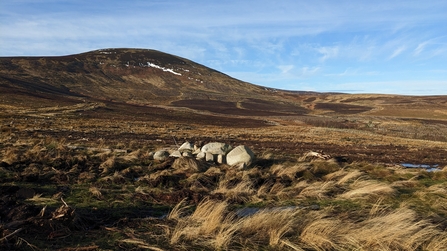
Threestoneburn Landscape. Image by Ella Farley.

Threestoneburn Landscape. Image by Ella Farley.
The NPP is a collaborative effort that aims to draw finance to survey, manage and restore degraded peatlands in Northumberland. It collaborates effectively with landowners and its partners to scope new sites for restoration and to produce shovel-ready plans.
Since the establishment of the partnership in 2022, the five-person team has been surveying tirelessly using GIS, remote sensing, aerial and drone imaging.
Areas surveyed reached as far as Holburn Moss and The Cheviots in the north to The Wou in the south. Other notable sites include the Border Mires, Kielderhead Moor and Whitelee Moor.
Conditions on the sites varied broadly from blanket bogs to basin mires - all varying massively in condition giving them their characteristic properties.
In addition, a number of sites are more heavily grazed than others and possess bare peat, which influences the vegetation that can grow there.
A maximum peat depth measures the distance from the surface that the peat extends before hitting bedrock or another substrate, in this case a peat rod detected peat 10m below the surface before transitioning to an alternative substrate.
In total, eighty-two unique bog-specific species were recorded including round-leaved sundew, cross-leaved heath, hare’s tail cotton-grass, heather, bog cranberry and bog rosemary and twenty-nine unique sphagnums.
The Maximum peat depth found was ten metres. All the survey findings on peat depths, vegetation present, vegetation communities and overall peatland condition will help to inform restoration plans that will be used for applications for future funding.
Alex Robinson, Northumberland Peat Partnership Engagement Officer says:
“It’s an incredible achievement that has been reached in little over three years with part of it during the tail end of Covid.
“Funding from The Esmée Fairbairn Foundation sets the partnership up for an exciting future surveying these landscapes which we are very grateful for.”
Robert Mayhew, Head of Conservation & Environment at Northumberland National Park Authority says:
“Healthy, functional peatlands play a leading role in addressing both the climate and nature crisis, and we’re delighted to see the progress being made by Northumberland Peat Partnership in identifying degraded peatlands across Northumberland and the subsequent work needed to restore them.
“We look forward to continuing to do more for nature with our partners in the future and protecting these important landscapes for future generations.”
Members of the public sign up to become peat inspectors via The Wildlife Trusts’ Hidden Peat Campaign Precious Peatlands | The Wildlife Trusts. The volunteer role involves looking for items in shops that contain peat and filling out a survey which asks how easy it was to find items that are peat-free and how clearly labelled they were.
Information gathered through surveys and social media will give The Wildlife Trust a clearer picture on what retailers are doing which can be used in future campaigns.
The Esmée Fairbairn Foundation has provided the partnership with funding for five years with the first 18 months of the project funded by the Nature for Climate Peatland Grant Scheme.
The Northumberland Peat Partnership partner organisations are Northumberland Wildlife Trust, Northumberland National Park Authority, Tweed Forum, Natural England, Northumberland County Council, Ministry of Defence, Environment Agency, Forestry England, Northumbrian Water, National Trust.